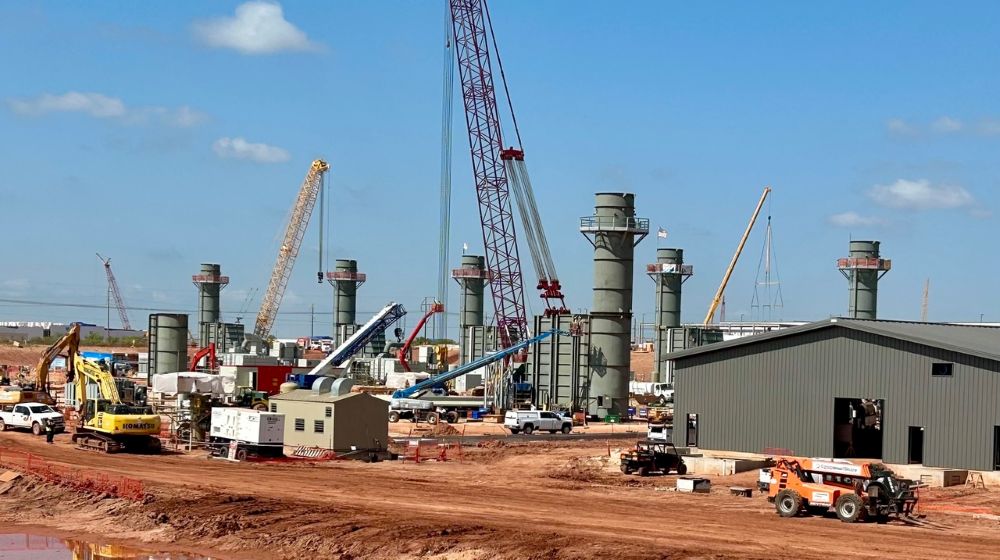The AI data center boom is now a big and freewheeling American business story. According to the U.S. Energy Information Administration, this quickly emerging industrial demand for power will help drive U.S. electricity generation to all-time highs not just this year but next year as well. One of the bottlenecks to this growth, however, can be found in the long wait these commercial enterprises must endure to actually get a connection to the grid. The U.S. has been enjoying a manufacturing revival, and growing enterprises, from data centers to new semiconductor facilities, are facing lengthy queues to plug into the grid. If the wait is too long, many of these data centers simply won’t get built. What if there was a quicker solution to their power needs?
Increasingly, data center developers are turning to on-site power generation packages that they themselves can control. Arrays of leading-edge natural gas turbines, installed directly on data center properties, can not only provide power but offer backup and resiliency services as well. Better still, at a time when more variable renewable energy is on the ascent around the world, these turbines can interact nicely with the ebb and flow of that power. Last year, combined wind and solar provided more than 17% of U.S. total power generation — a very high level of penetration for such a new form of energy.
Crusoe, a renewables-focused developer of data centers and the power infrastructure they require, has been sourcing high-efficiency natural gas turbines from GE Vernova to provide this stability. Last December, the company ordered 10 LM2500XPRESS aeroderivative gas turbines to be installed at the data center it’s building outside of Abilene. Now Crusoe has announced the acquisition of another 19 LM2500XPRESS units for its operations. Combined, the 29 units are expected to provide nearly 1 gigawatt of electrical power.
These high-tech turbines are modular, easy to install, fuel flexible, and powerful. For some settings, they can even be mobile. A typical single LM2500XPRESS aero unit with around 35 megawatts produces roughly the same power as 11 or 12 diesel generator sets. By making this one change, data centers can save on emissions, real estate, switchgear, transformers, and their overall footprint. But that’s not all. By building in such robust backup to each data center’s capability, heavy-duty gas turbines or an array of aeroderivative turbines can reach the critical mass needed to run AI computing entirely off the grid, and can even sell power back to the grid. “This is the evolution we are experiencing, along with our customers, to enable future growth,” says Midhat Mirabi, managing director of Aero New Units at GE Vernova.

Researchers at GE Vernova anticipated this new set of demands years ago as the company began preparing for the AI revolution. They concluded that innovative new gas turbines could be marshaled to support renewable energy infrastructure around the world. Aeroderivative turbines are unique in that they are highly calibrated, can work together as a flexible power rack, can operate on either gas or liquid fuel, possess up to 100% hydrogen capability in some models (for future fuel flexibility), and can turn on and off so rapidly they function almost like a battery. Germany, for example, chose to build a rack of LM2500XPRESS turbines last year at the Biblis Grid Stability power plant, which is dedicated entirely to filling in brief gaps in grid power as the country continues its ascent to ever higher levels of renewables penetration.
Unlike fixed-site natural gas plants, which function as major nodes in any power grid, these flexible, even transportable turbines will sit “behind the meter” — that is, a power supply that’s not officially part of the wider grid but, like a homeowner’s rooftop solar array, produces power on-site. In other words, this is an energy supply that’s not coming from the grid but could flip around if necessary and provide power back to the grid, potentially earning income in the process. Think of it as grid-connected but not grid dependent. The positioning suggests a new kind of entity that can access grid energy most of the time but can withdraw during outages, like a crab into its shell, to survive on its own power until another day.
The increasing demand for power has taken the world by surprise as electric vehicles, industrial operations, and now hungrier-than-ever data centers jack into the grid. But as GE Vernova CEO Scott Strazik pointed out last year at Climate Week NYC, growth is the best ally of climate optimism, because it provides the forward momentum to adopt, and afford, new solutions. In these phases of high renewables growth, the flexibility and high efficiency of the latest gas turbines have been shown to work almost symbiotically with the mighty rise of renewable but variable wind and solar. “You help me and I will help you” describes the arrangement.
“This is a new segment,” says Mirabi — one that aspires to be ecologically friendly but that has to be made more robust. “And we at GE Vernova very much want to participate in this new area of demand.”
